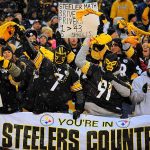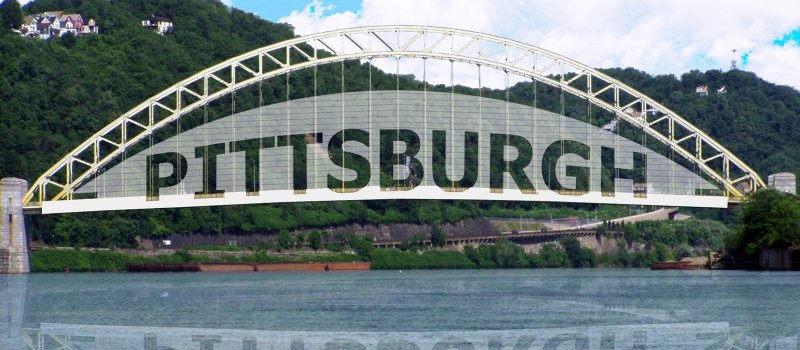Our plan is to drape locally-produced welded wire mesh across the cables of the West End Bridge for the 2016 Pittsburgh Bicentennial celebration. The design, which will mark the western edge of the City, is celebratory, contextual, and affordable.
We are in Pittsburgh, a couple years from now. It is a fine mid-October day. Once again, the Steelers are in the hunt for the playoffs, and the construction of the West End Bridge’s new pedestrian arch is finally complete. From the Point, one can see football fans streaming to Heinz Field across the Pittsburgh Bridge, as it has come to be known, for the game. Above the multitude, the “Pittsburgh” sign shimmers gaily in the early afternoon sun. From the bridge, pedestrians stop to admire the view of their city and lean against the mums filled planters. Vendors are selling pierogies and hotdogs from the cantilevered alcoves that extend over the Ohio River below the huge letters. Joggers and bicyclers crossing the river from the tree-lined North and South Side river trails only add to the festive spirit. The bridge has already become an icon of the city of Pittsburgh, joining the incline, the stadiums, the hills, and the rivers.
 Pittsburghers love their city, and they have great fondness for the city’s markers. What people have remarked upon is how the sign can look so different depending on the weather or time of day. Much of the time, the metal screen is barely visible against the gray Pittsburgh skies, which is as it should be. The effect is subtle. Other times, especially in the sun with blue sky beyond, the screen becomes highly visible, throwing the letters into stark relief. At night, the screen colors can be as varied as a rainbow, depending on the light that is directed upon it.
Pittsburghers love their city, and they have great fondness for the city’s markers. What people have remarked upon is how the sign can look so different depending on the weather or time of day. Much of the time, the metal screen is barely visible against the gray Pittsburgh skies, which is as it should be. The effect is subtle. Other times, especially in the sun with blue sky beyond, the screen becomes highly visible, throwing the letters into stark relief. At night, the screen colors can be as varied as a rainbow, depending on the light that is directed upon it.
Some loyal Pittsburghers have remarked upon the fact that the letters are defined not by the presence of the screens, but rather by their absence. These people have interpreted this to indicate that the meaning of our city is defined not by its form but by what is left over when the form has gone away, namely our people and their character.
 Pittsburghers love their city, and they have great fondness for the city’s markers. What people have remarked upon is how the sign can look so different depending on the weather or time of day. Much of the time, the metal screen is barely visible against the gray Pittsburgh skies, which is as it should be. The effect is subtle. Other times, especially in the sun with blue sky beyond, the screen becomes highly visible, throwing the letters into stark relief. At night, the screen colors can be as varied as a rainbow, depending on the light that is directed upon it.
Pittsburghers love their city, and they have great fondness for the city’s markers. What people have remarked upon is how the sign can look so different depending on the weather or time of day. Much of the time, the metal screen is barely visible against the gray Pittsburgh skies, which is as it should be. The effect is subtle. Other times, especially in the sun with blue sky beyond, the screen becomes highly visible, throwing the letters into stark relief. At night, the screen colors can be as varied as a rainbow, depending on the light that is directed upon it.



